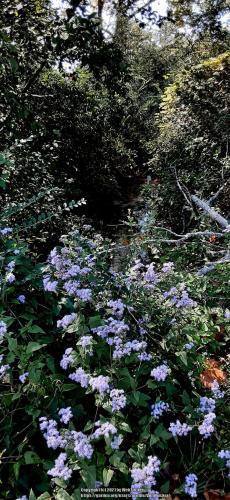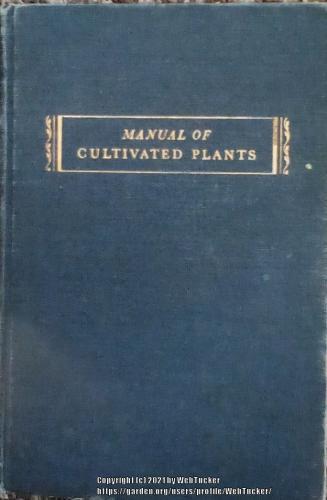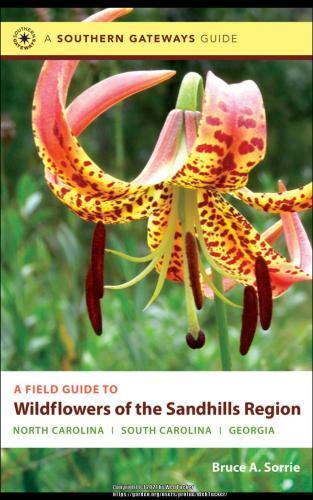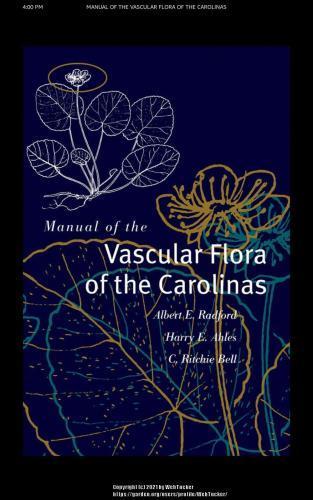Wikipedia is a helpful online source. Here's a screenshot of a Wikipedia page that I took on my tablet to show as an example.

The thing I like about this resource is not only do they provide a description of the plant and the classification of the plant but they also provide a list of synonyms or previous names of the plant. This is very helpful to someone who has been out of the game for a while.
So the example that I have posted above is of Conoclinium coelestinum. I knew this plant, but I knew it as Eupatorium coelestinum rather than Conoclinium. As a result when I tried to find the plant at the National Gardening Association site I came up with a blank. I don't remember the exact circumstances, but I eventually found out that the name had changed, and I can see the old name right here on this Wikipedia page under the synonyms list. This really helped a lot when I was trying to figure out what was going on with this particular plant, and its name had changed. So, Wikipedia can be helpful.

So the second favorite book in my collection of books on plants is the "Manual of cultivated plants" by L.H. Bailey printed by McMillan company in 1949 and 1951. I was able to find a Kindle version of the other book I love and use it on my tablet all the time while I'm working. I have not looked for this book in a Kindle version but I doubt it's available. In fact I just went and looked on the Amazon site and see only hardback used copies are available. That's okay, I love my hard back version of the book. This book has an amazing amount of information on cultivated plants in the United States and the world. One of the things I love about it best is that it has translations of the Greek and Latin versions of the scientific names which help me remember the names because usually they're very descriptive of what the plant looks like. The example I'm gonna use here is one of my non-native plant entries, Antirrhinum majus. LHB provides or translates the Greek Antirrhinum to "like nose". Snapdragons kind of look like noses. The thing that helps me Is the Greek translation anti- is like and -rrhinum is nose. That helps me remember the name.

Another resource I use is new to me. Here the cover is depicted from a screenshot of my Kindle version of the book. Bruce Sorrie and his work is of a particular interest to me because I live in the sandhills region of North Carolina which this book addresses specifically. Though not just North Carolina, it covers South Carolina and Georgia as well.

NEXT STEPS.....
Another tried and true method I use for plant identification Is also helpful. Though I readily admit it it doesn't always work. So my next method I recommend with caution:
Scenario
I have a plant That I cannot identify based on it's taxonomy. Why can't I identify it that way? Well, I'm not an expert on taxonomy of plants or anything else. I only know enough to be dangerous. So in the scenario I can't identify it based on what it is like it's leaves maybe yeah it's leaf pattern?Yeah! It's leaf shape? Yeah! all the basic stuff? Yeah! I can get all that and other basic structure and anatomy. Its when I get down to the very nitty gritty. Especially when you're dealing with things like asters. It gets really complicated taxonomically speaking.
So What do I do? I use the other information that's available to me. You ask what information? Or maybe not. But the other information is geographic location, habitat, habit ex cetera. There are other things that you can use to help you discover what the plant is based on those other pieces of information. So, look at all the stuff you understand that is available and that helps narrow it down and usually to the species.
When you don't have that information or it's inclusive that's when you go to step 5. Get help from experts like people at this website, and people at botanical gardens and other places that employ experts at plants and plant identification.

This book is another of my favorite references for identfying plants and understanding the meanings of their names. Asa Gray is a famous botanist well known in the botany world, and he spent a great deal of time right here in my home state of North Carolina during the summer of 1841. So, I'm proud to use his book as one of my most favorite of reference books.
This volume is published by the American book company in 1889 and is the 6th edition of the book. The official title is "Gray's manual of botany of the Northern United States". It's a great book and if you can find a copy of it I recommend picking it up and enjoying it's contents. What a wonderful addition to my botany library when I found it in a used book store on Front street in Wilmington North Carolina back in the 1980's.
A note on Gray's organization: The organization of plants uses order numbers rather than the " modern" usage of family numbers.
Post 1
November 7, 2021
Let me say 1st that I'm no expert in the field of plant taxonomy and identification . I did study biology, and I have had a long love for plant photography and identification that began in my studies in college, and as a seasonal naturalist at a state park in North Carolina.
Historically my main reference book for plant identification has been "Manual of the vascular flora of the Carolinas" by Albert E. Radford, Harry E. Ahles, and C. Ritchie Bell. Published by the University of North Carolina press in 1968 most recently. Other sources to follow in future posts.

Notations in the captions of my photographs include a reference to this text with family number, genus number and species number. Thus, my first native plant entry Nymphaea odorata is followed with the notation #1 (RAB p. 449, 73-2-1). This means my first native plant entry in my Natives list with a page number and family, genus and species reference numbers from the source above. The caption may also include other relevant information.